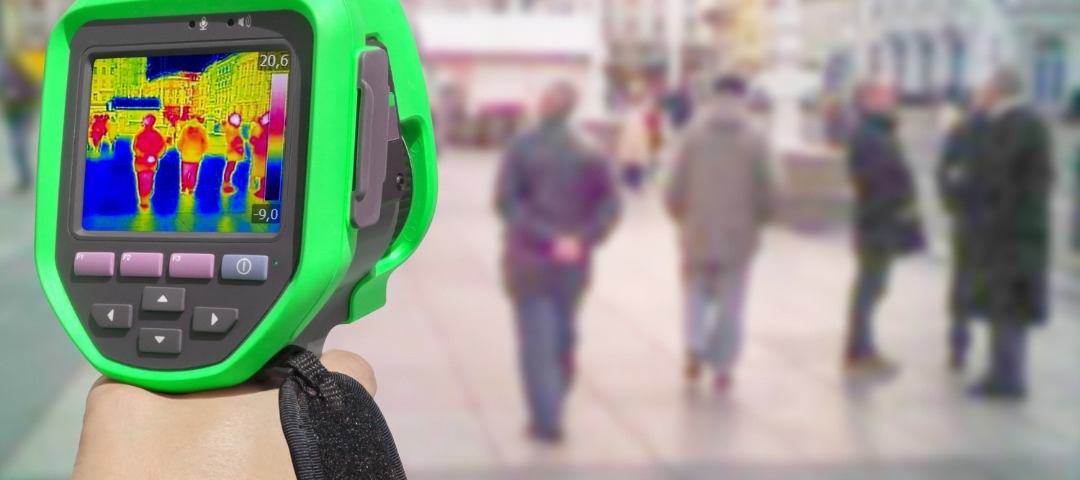What is Human Thermal Imaging?
The process of Thermal Imaging, also known as Infrared Thermography, involves a thermal camera capturing images of objects or people by using infrared radiation emitted from them which depends on the material’s properties and emissivity. The radiation captured falls in the long-infrared range of the electromagnetic spectrum that is middle wavelength (3 µm) to long-wave infrared (14 µm) and is captured by thermographic cameras to generate images called thermograms with or without illumination. This is because infrared radiation emitted by any object imparting a temperature above absolute zero (-273°C/-459°F) can be seen irrespective of visible light, and the radiation is directly proportional to its temperature.
Cameras equipped with infrared detectors capture the radiation within their field of view and focus it on a sensor array or detector chip with multifold pixels on a grid. This data is translated into an image by the software. Thermal images showcase variations in color because of the differential temperature between the object, its interior portion, surface and environment. For example, any homoiotherm like human beings in a cold environment irrespective of day or night, would be rendered with yellow and shades of gray, which gradually turns to orange and red towards the interior as the temperature rises. In many cases, grayscale images are used that differentiate thermal image of human body as brighter gray as compared to one’s surrounding. Long-wave and mid-wave thermal energy can be detected using Focal Plane Arrays which can be cooled (cameras made with components consisting of Mercury, Cadmium with cryogenic systems etc.) or uncooled (consisting of Vanadium with wide aperture lenses of ƒ/1.0 to ƒ/2.0 for more energy passage through the sensors etc.) detectors. Equipped with accurate sensors, such detectors can reduce noise and capture images of temperature differences even below 0.02°C and at a distance of 50 kilometers. The thermal imaging market was valued at $6.2 billion in 2021 and is expected to rise to $8.7 billion by 2026, mainly due to its application in detecting COVID-19 infected people.

Market size of human thermal imaging in various industries from 2021 to 2026
Applications of Human Body Thermal Image
Thermography can be classified as active, where a heat source is applied to an object for inspection of material, or passive, where an object’s naturally emitted thermal energy can be observed. Thermograms of human bodies find various applications across industries, some of which are discussed below:
Surveillance
Thermal imaging is ideal for military operations, border surveillance, homeland, perimeter, event security and other video analytics surveillance by law enforcement authorities since they can detect intrusion, perform human action recognition, moving targets and threats to the public effectively during both day and night. In the case of dangerous or hazardous areas, sensors can detect excessive radiation and provide a warning before entering. Furthermore, it is used to rescue lost or trapped victims of natural disasters who may be stuck under rubble or debris from non-ductile collapsed building structures during earthquakes or beneath dense snow during avalanches. Thermal image of human body can be used to locate missing persons, hikers, campers by detecting their thermal signatures in natural surroundings during adverse conditions or night. It enables rapid response to detect and contain wildfires in early stages.
It can be used in UAV drone land surveying for environmental surveillance to detect differential temperature over large areas of land, fields, forests etc. It ultimately increases efficiency of agricultural and forestry practices through crop monitoring, pest detection, vegetation pattern assessment, targeted fertilization and irrigation, determination of level of water stress and nutrient deficiency through thermal data. It is also used for animal safety monitoring against poaching and hunting by detecting hunters in deep forest and restricted areas with obscured or low-light conditions. It can be used by wildlife researchers to track the movement of endangered, nocturnal animals and species living within dense vegetation, conduct population surveys, identify habitat threats and implement human-wildlife conflict mitigation strategies.

Working of thermal imaging cameras
Healthcare
Human body thermal images are part of computer vision applications in healthcare. Thermographic imaging can be used to monitor physiological changes in human beings for clinical diagnostics and other homoiotherms under research. It is used for detecting certain allergies in veterinary practices. These cameras were widely used as thermal scanners during the H1N1 pandemic for screening out airport personnel who were suspected of swine flu in 2009. In telemedicine, healthcare professionals can remotely monitor patients’ bodies for timely medical interventions against contagious disease and cross-contamination. It acts as a novel tool for measuring skin surface temperature and investigation of tissue strain due to physical exercise in physiotherapy, namely non-contact thermography. It is also used for body organ screening for detecting abnormality in temperature etc.

Human thermal imaging for disease detection
Automotive
It is used widely in the automotive industry to detect visible defects non-invasively during car assemblies and testing. Human thermal imaging is an excellent addition to automotive sensor stacks as it is used for modules of Advanced Driver Assistance System such as driver vision, driver monitoring, passenger detection, pedestrian detection in dark areas and other in-cabin applications. It reduces risk posed by many factors such as glare, animal crossings, traffic congestion and highly populated areas. This life-saving technology increases driver alertness multifold, assuring a reduction in accidents, especially in the case of foggy or smoggy weather.
Manufacturing
It acts as a non-destructive test method in vision inspection systems to find deterioration in machinery and detect components at higher temperature prior to failure. It also finds application in detecting defects in shafts, pipes, metal or plastic parts. In exceptional cases like manufacturing of certain chemical solutions in dark conditions, it can be used to find objects. Technicians utilize this technique to localize overheating sections of power lines and check for thermal signatures from heat leaks of faulty wire insulation in air-conditioning units. Thus, it is used for conditional monitoring of electrical and mechanical systems and building diagnostics, for example, detecting moisture, water leaks, energy losses, structural defects within walls or beneath floors etc.
Others
Over the years, human body thermal image equipment has been used by firefighters to see through smoke caused by fire, locate the base of it and rescue victims of arson and other contingent situations. It is applicable to containing the population of rodents in concealed areas. It is an excellent addition for drones with collision avoidance capabilities.

Rescue workers using thermal image of human body at Chernobyl
Limitations of Human Thermal Imaging
One of thermal imaging’s major shortcomings is that glass lenses used to focus visible light on thermographic camera sensors are not transparent to thermal radiation. This means thermal cameras cannot observe people through building or vehicle windows. Thus, thermal lenses are constructed with Germanium, a rare element costing more than ₹2 lakhs per kilogram. An alternative to Germanium is chalcogenide-based lenses. As we are aware that thermal imaging defines objects using contrasting temperatures as compared to colors and shadows common to the human eyes for the purpose. Inability of visual contrasting renders thermal imaging as non-effective in distinguishing printed text and images where surface temperature of objects in uniform. Although thermal cameras allow computer vision object detection beyond other apparatus, these cannot identify people, especially in the case of long-range thermal imaging. Thermal sensors have a limited resolution of 640 x 480 pixels as compared to other visible sensors.
Overcome the Shortcomings of Human Body Thermal Images with KritiKal
KritiKal has a wide ecosystem of partners and vendors who develop a variety of lenses which are seamlessly integrated with the entire system including sensors, software and third-party apps against the shortcomings of cameras capturing thermal image of human body. It has expertise in working with mid-wave infrared cooled thermal cameras that partially see through glass and identify basic features of a person of interest. It has worked with advanced forward-looking infrared (FLIR) that can capture ultra sharp images with a resolution of 1280 x 960 pixels and multi-sensor systems for better imaging. Please mail us at sales@kritikalsolutions.com for your specific needs and let us configure custom-designed solutions that work best for you.
Human body thermal imaging is a versatile technology with a wide range of applications in threat detection across different industries. It provides valuable insights that improve safety, security, and efficiency in areas such as security, law enforcement, healthcare, wildlife conservation, and agriculture. With ongoing technological advancements, the potential of thermal imaging in threat detection is expected to grow, leading to a transformation in how we detect and address potential threats in our surroundings.

Rishabh Jain currently works as a Senior Software Engineer at KritiKal Solutions. He is extensively skilled at C++, HTML, CSS, AI/ML and more technologies and platforms. He has assisted KritiKal in delivering various projects with team player abilities and hands-on experience in software design and development.



 Global
Global  United States
United States 
